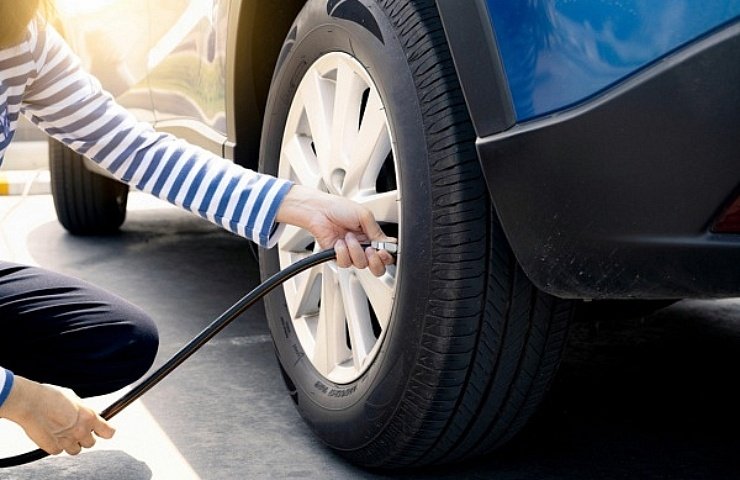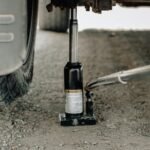Understanding Air Compressors
Air compressors are versatile machines designed to convert power into potential energy stored in pressurized air. This process allows many applications across various industries, with one of the most common uses being the inflation of tires. By compressing the air, these devices create a high-pressure environment that enables quick and efficient inflation. Understanding the function of an air compressor is crucial, especially when considering the appropriate size for specific tasks, such as inflating tires.
There are several types of air compressors available on the market today, each suited for different applications. The most common types are portable, stationary, and reciprocating compressors. Portable air compressors are particularly useful for personal or home use, as their compact design allows for easy transport and operation in various locations. Stationary models, on the other hand, are typically larger, designed for more extensive tasks and applications within professional environments. Reciprocating compressors utilize pistons to generate pressure, while rotary screw compressors employ a dual-screw mechanism for continuous operation.
In addition to their use in inflating tires, air compressors serve a multitude of other purposes, including powering pneumatic tools, spraying paint, and providing air for various industrial processes. The efficiency and reliability of an air compressor hinge significantly on its size and capacity. When selecting an air compressor for inflating tires, several factors must be taken into account, including the tire’s required pressure, the flow rate of the compressor, and how quickly an individual needs to inflate the tire.
By comprehending the basic functions and types of air compressors, users can make informed decisions regarding the appropriate size needed for tire inflation. Understanding these factors lays the groundwork for broader considerations regarding the optimal selection of an air compressor tailored to specific needs.
Important Specifications of Air Compressors
When selecting an air compressor for tire inflation, several key specifications must be considered to ensure optimal performance. Among these specifications, Pressure (PSI), Cubic Feet per Minute (CFM), and tank size are the most critical factors that contribute to an air compressor’s overall effectiveness.
Pressure, typically measured in pounds per square inch (PSI), is a fundamental aspect to review. For inflating tires, it’s important to choose a compressor that can deliver the necessary PSI required by your vehicle. Most car tires operate within a range of 30 to 35 PSI; thus, an air compressor that can achieve at least 100 PSI will ensure sufficient pressure for inflation. This capability is essential not only for tire inflation but also for maintaining the precision needed for safety and performance.
Cubic Feet per Minute (CFM) is another crucial specification that defines the compressor’s ability to deliver a flow of air. The CFM rating indicates how much air the compressor can provide in a minute, which affects the time taken to inflate tires. A higher CFM rating generally translates to faster inflation speeds. When selecting an air compressor, it is prudent to ensure that its CFM value meets or exceeds the requirements of your tire inflator or tools, thereby enhancing efficiency during use.
Lastly, the tank size of an air compressor can significantly impact its usage. A larger tank can store more air, which can be particularly advantageous when multiple applications or continuous inflation are necessary. Conversely, a smaller tank may lead to more frequent cycling, potentially resulting in delays during inflation. Therefore, evaluating the intended usage and expected workload is essential when determining the appropriateness of tank size for tire inflation needs.
Factors to Consider for Tire Inflation
When selecting an air compressor for the specific task of inflating tires, several critical factors must be taken into account to ensure optimal performance and efficiency. Understanding these elements will help users choose the appropriate compressor tailored to their individual requirements.
Firstly, tire size plays a significant role in determining the compressor’s capabilities. Different tire sizes require varying amounts of air pressure to achieve adequate inflation. For instance, larger tires, such as those found on trucks or SUVs, typically require a more powerful compressor compared to smaller tires used in compact cars or motorcycles. It is essential to consult the vehicle’s manual for the recommended psi (pounds per square inch) for each tire, as this dictates the compressor’s specifications, particularly its pressure output and flow rate.
Secondly, the type of vehicle also influences the selection process. Cars, trucks, and motorcycles have distinct tire inflation needs based on their design and intended use. For example, if the primary focus is on a passenger vehicle, a portable compressor with a lower psi rating may suffice. Conversely, for larger vehicles or those that necessitate frequent tire inflation, a higher-capacity compressor could be more suitable. Additionally, examining the compressor’s durability and portability can also play an essential role in its suitability for varying vehicle types.
Lastly, frequency of use is a crucial element to consider. Those who inflate tires regularly, such as automotive enthusiasts or commercial vehicle operators, may opt for a more robust and powerful compressor that can withstand frequent use. In contrast, casual users who inflate tires occasionally may benefit from a lightweight, compact compressor that is easy to store and transport. Evaluating these factors carefully can help individuals select the optimal air compressor for their tire inflation needs.
Recommended PSI for Tire Inflation

The appropriate tire pressure, measured in pounds per square inch (PSI), is essential for optimizing vehicle performance, fuel efficiency, and safety. Each type of vehicle has its specific PSI requirements. For instance, passenger vehicles typically recommend a tire pressure between 30 to 35 PSI, though this can vary depending on the manufacturer’s specifications. It is crucial to consult the owner’s manual or the tire placard located on the driver’s side door jamb for the precise requirements.
For light trucks and SUVs, the recommended tire pressure often ranges from 35 to 45 PSI. Maintaining the proper inflation in these vehicles enhances load-carrying capacity and improves handling, particularly when driving under varied conditions such as towing or carrying heavy cargo. Similar to passenger vehicles, checking the manufacturer’s recommendations for these vehicles is vital, as tire pressure may differ based on the load and tire specifications.
Bicycles, on the other hand, have different PSI requirements depending on the type of tire. For example, road bike tires typically require a pressure range of 80 to 130 PSI, while mountain bike tires usually operate best at about 30 to 40 PSI. Inflating bicycle tires to the correct pressure not only aids in ensuring a smooth ride but also prevents unnecessary wear and tear on the tires.
Maintaining the recommended PSI in tires is vital for safety reasons. Under-inflated tires can lead to decreased fuel efficiency and increased tire wear, while over-inflation can cause reduced traction and a rough ride. Therefore, by adhering to manufacturer recommendations for tire pressure, vehicle owners can ensure optimal performance and prolong the lifespan of their tires.
Understanding CFM Requirements
Cubic Feet per Minute (CFM) is a critical measurement that indicates the airflow rate produced by an air compressor. It plays a significant role in determining the efficiency and effectiveness of inflating tires. When selecting an air compressor for this purpose, understanding the CFM requirements relevant to your tires is essential. Generally, larger tires require a higher CFM rate to achieve the desired pressure more quickly, while smaller tires can be inflated with lower CFM values.
Typically, tire inflation requires a CFM rating between 2 to 6 CFM. For instance, passenger vehicle tires often necessitate a compressor that can deliver around 2 to 3 CFM at 90 PSI for efficient inflation. Conversely, tires found on larger vehicles, such as trucks or SUVs, may demand compressors with higher CFM outputs to ensure an adequate and timely inflation process. Thus, when assessing your needs, you should identify the size of your tires and the speed at which you want them inflated to select the appropriate compressor.
In addition to tire size, consider the efficiency of the air compressor itself. A higher CFM rating allows the tire to reach its optimal pressure swiftly, reducing the time spent on inflation. For those who regularly inflate tires for more than one vehicle or engage in frequent tire maintenance, it might be prudent to invest in a compressor with a CFM rating on the higher end of the spectrum. It’s also important to account for factors such as tire condition and ambient temperature, as these can influence the required CFM for effective inflation.
Ultimately, understanding the CFM requirements will empower you to choose an air compressor that aligns with your specific tire inflating needs, ensuring a seamless and efficient inflation experience.
Choosing the Right Tank Size
When selecting an air compressor, one critical factor to consider is the tank size. The tank is essential for storing compressed air, which facilitates uninterrupted operation for various tasks, including inflating tires. Understanding the requirements of your application will help determine the most suitable tank size, impacting the compressor’s efficiency, recharging time, and overall productivity.
For occasional use, such as inflating tires or small air tools, a smaller tank—typically between 2 to 6 gallons—can suffice. These compact compressors are lightweight and portable, making them ideal for infrequent or recreational applications. The primary advantage of a smaller tank is that it reduces the compressor’s weight and size, allowing for easy transportation and storage. However, it is important to note that compressors with smaller tanks may require more frequent recharging, especially when used for tasks that demand continuous air flow.
In contrast, for heavy-duty applications or continuous workloads, a larger tank is generally recommended. Compressors with tank sizes ranging from 10 to 30 gallons are suitable for users who operate air tools extensively or conduct larger projects requiring a stable air supply. The increased capacity enables the compressor to store more air, thereby reducing the frequency of recharging, which leads to improved efficiency and productivity. This is particularly beneficial for tire shops or professionals who rely on air tools for extended periods.
Ultimately, choosing the right tank size is about balancing your specific needs with convenience. By evaluating how you plan to use the compressor and the type of tasks you will perform, you can make an informed decision that enhances your productivity while ensuring that you have the necessary air supply. A correct tank size not only influences performance but can also extend the lifespan of the compressor itself by minimizing wear and tear associated with frequent cycling.
Portability vs. Power: The Trade-Offs
When selecting an air compressor for inflating tires, one of the most crucial factors to consider is the balance between portability and power. Each type of compressor offers distinct advantages and disadvantages that can significantly influence the user’s experience and effectiveness in meeting tire inflation needs.
Portable air compressors are designed for convenience and ease of use. Typically lightweight and compact, these models can be effortlessly transported in a car’s trunk or stored in a small garage space. This portability makes them ideal for individuals who need to inflate tires on the go, such as those who frequently travel or participate in outdoor activities. Moreover, most portable air compressors operate on standard electrical outlets or even car batteries, generating the flexibility that users often appreciate. However, portability does come at a cost; these models usually deliver lower power output compared to stationary models, potentially limiting their efficiency in inflating larger tires or multiple tires quickly.
In contrast, stationary air compressors are designed for more substantial power and typically provide higher pressure levels. These compressors can handle frequent and intensive use, making them suitable for automotive shops or serious enthusiasts who frequently need larger volumes of air. The downside, however, is their lack of portability. Stationary compressors are often heavy and bulky, requiring dedicated space and possibly a more complex setup. This can be an inconvenience for occasional users or those with limited storage. Additionally, the power consumption for these units can be higher, which may result in increased energy costs over time.
In assessing the trade-offs between portability and power, consumers must evaluate their specific tire inflation needs against their lifestyle. Choosing the right air compressor size not only aids in achieving optimal tire pressure but also ensures that the compressor fits into one’s daily routines and use cases effectively.
Features to Look For in a Tire Inflator
When selecting an air compressor for tire inflation, it is crucial to consider various features that can enhance usability and efficiency. One of the first features to look for is the digital gauge. A reliable digital gauge provides precise pressure readings, allowing users to monitor and adjust tire pressure accurately. This is important not only for maintaining optimal tire pressure but also for ensuring safety and improving fuel efficiency.
Another significant feature to consider is the automatic shutoff function. This feature automatically turns the compressor off once the desired tire pressure is reached, preventing over-inflation and, subsequently, potential tire damage. Automatic shutoff adds a layer of convenience, making the inflation process user-friendly, especially for beginners.
Attachments and accessories are also key components when choosing a tire inflator. Having various nozzle attachments allows the compressor to serve multiple purposes beyond just tire inflation. Look for models that come with adaptors for sports equipment, inflatables, and other inflatables, which adds versatility to your air compressor investment.
Furthermore, noise levels should not be overlooked. Many traditional air compressors can be quite loud during operation, which may be a concern for users in noise-sensitive environments. Opting for a quieter model can significantly enhance the user experience, making the task more pleasant.
Lastly, consider the portability and power source of the tire inflator. Compact models are easier to store and transport, while compatibility with car batteries can be advantageous for on-the-go inflation. Each of these features contributes to a more efficient and effective tire inflator, ensuring that you choose the right air compressor suited to your specific needs.
Maintenance Tips for Your Air Compressor
Regular maintenance of your air compressor is crucial for ensuring its longevity and optimal performance, especially when using it for inflating tires. Proper upkeep not only enhances efficiency but also reduces the likelihood of unexpected breakdowns. To achieve this, it’s essential to establish a routine that incorporates several key practices.
First and foremost, regularly check the oil level if your air compressor is oil-lubricated. Keeping the oil at the recommended level aids in minimizing friction and wear on internal components. If the oil appears dirty or contaminated, a change is necessary to maintain optimal performance. It is also advisable to clean or replace the oil filter to prevent debris from affecting the compressor’s functioning.
Another important maintenance step involves monitoring the air filter. A clogged air filter can restrict airflow, thereby reducing operational efficiency. Inspect the air filter periodically and clean it if it’s reusable. If the filter shows signs of wear or damage, replacement is essential to ensure proper air intake.
In addition to these checks, inspect the hoses and fittings for any signs of wear, leaks, or damage. A compromised hose can lead to reduced efficiency and potential safety hazards. Tightening loose connections and replacing worn-out hoses will help maintain air pressure and overall performance.
Cleaning the exterior of your air compressor is also beneficial. Dust and debris can accumulate over time, potentially affecting cooling and airflow. A simple wipe-down with a damp cloth can improve the compressor’s performance and prevent overheating.
Finally, always refer to the manufacturer’s guidelines for specific maintenance recommendations tailored to your air compressor model. By adhering to these maintenance tips, you can significantly extend the life of your air compressor, ensuring it continues to function effectively for tire inflation and other applications.

